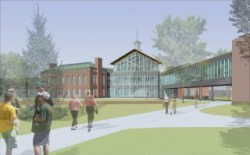Jan 11 2010
When the new 56,000-square-foot student center opens its doors in August at Clarkson University, not only will the building enhance social and cultural life on campus, it will also exemplify how Clarkson research pays off in the real world.
 Architect's rendering of new Clarkson University Student Center
Architect's rendering of new Clarkson University Student Center
Thanks to Civil Engineering and Environmental Engineering Professor Narayanan Neithalath, the building utilizes locally produced concrete blocks that are more economical, energy-efficient, and environmentally friendly than traditional ones.
They are also stronger and more durable. And all of these improvements occur because 20 percent of the primary − and most expensive − ingredient in concrete, Portland cement, has been replaced with recycled industrial glass powder.
What sparked development of these ¡°green¡± blocks was a challenge faced by Potters Industries, a major international manufacturer of engineered beads made entirely from recycled glass. Its local plant was generating 8,000 tons of excess fine powder a year while making tiny pieces for high-tech applications that range from reflective highway lane paint to hypodermic needles. Potters sought an efficient use for this byproduct, which looks and feels like grayish-white baby powder.
Enter Neithalath, an expert on cement-based materials and sustainable concretes and an affiliate of Clarkson¡¯s Center for Advanced Materials Processing (CAMP).
Funded by the New York State Department of Economic Development Environmental Investment Program and the New York State Foundation for Science, Technology and Innovation through CAMP, he began the project¡¯s research in June 2006 and concluded it in December 2008 after extensive field tests at Woodruff Block, a manufacturer in Potsdam. The company produced 7,500 blocks for the student center using Neithalath¡¯s innovative formulation.
Concrete is the world¡¯s most widely used man-made material. Some 12 billion metric tons are churned out each year (a cubic meter for every person on the planet) as infrastructure for roads, bridges and buildings.
About 75 percent of it is Portland cement, a limestone-based binder whose production significantly depletes natural resources and also stresses the environment. The costly, energy-intensive manufacture of cement, for example, is a major source of carbon dioxide emissions. Thus replacing it with powdered glass promotes sustainability by limiting pollution, reducing energy consumption, and preserving resources þu and saves money by utilizing a far less costly leftover industrial byproduct (in this case, one that has already been previously recycled).
And beyond these environmental benefits, Neithalath also determined that substituting this recycled glass powder for cement can actually improve concrete¡¯s mechanical performance. While researchers have previously blended other kinds of crushed or powdered glass with cement, no one had analyzed or tested the possibilities of adding the byproduct from industrial bead manufacturing.
Glass powder is effective in concrete primarily because it is loaded with silica, which can react with other cement components (calcium hydroxide, for example) to increase the material¡¯s strength through hydration (which leads to hardening).
Such so-called secondary binding compounds also reduce porosity and add to long-term durability. ¡°Therefore you can take away some of the expensive and energy-intensive Portland cement without losing any of its important properties -- and in fact you make the concrete better,¡± says Neithalath.
¡°Proportioning is critical,¡± he observes. ¡°Amounts of glass that are too high can make concrete weaker because it does not have enough calcium compounds to generate strength. Also, glass has lots of alkalis. In excess these might lead to chemical reactions that can compromise long-term performance.¡±
Working with two undergraduates and two graduate students, Neithalath conducted his research on Potters¡¯ byproduct powder just a short walk from where the student center is now pioneering his green concrete in its walls and elevator shaft with blocks that look and feel just like their traditional counterparts.
Source: http://www.clarkson.edu/